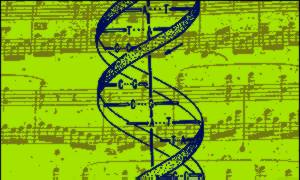
Your DNA Is a Song: Scientists Use Music to Code Proteins
John Roach
for National Geographic News
October 21, 2005
What are proteins? How are they structured? What's the difference between a protein in a human and the same protein in a lizard? Ask Mary Anne Clark these questions and she is likely to respond with an earful of music.
Clark is a biologist at Texas Wesleyan University in Fort Worth, and she's part of a growing field of science educators who use so-called protein music to help illustrate the basic structure of the building blocks of life.
All living things are made up of proteins. Each protein is a string of amino acids. There are 20 different amino acids, and each protein can consist of dozens to thousands of them.
Scientists write down these amino acid sequences as series of text letters. Clark and her colleagues assign musical notes to the different values of the amino acids in each sequence. The result is music in the form of "protein songs."
By listening to the songs, scientists and students alike can hear the structure of a protein. And when the songs of the same protein from different species are played together, their similarities and differences are apparent to the ear.
"It's an illustration transferred into a medium people will find more accessible than just [text] sequences," Clark said. "If you look at protein sequences, if you just read those as they are written down, recorded in a database, it's hard to get a sense for the pattern."
When people look at a page full of text corresponding to protein sequences, Clark explained, they tend spot clusters of letters but fail to see the larger pattern.
"If you play [the protein song for that sequence] you get that sense of the pattern much more strongly," she said. "That's my feeling at least. You hear stuff you can't see."
Different Songs
One song for a protein may sound different than another for the same protein, depending on how notes are assigned to amino acids' various properties. For example, Clark tends to arrange her compositions based on the protein's solubility.
"Where it's soluble and insoluble is one of the big factors in determining how [the protein] folds up," she said. Solubility influences how proteins fold, and those folds determine what category a certain protein belongs to.
In 1996 Ross King, a computer scientist at the University of Wales, Aberystwyth, wrote a program called Protein Music. It assigns a note to each of the three compounds that make up amino acids and a note to various amino acid properties—charge, solubility, and so on.
"This produces a chord for each amino acid," King wrote in an e-mail interview. "Because proteins are an interesting mixture of novel and repetitive elements, like music, the translation to music sounds interesting."
By changing the rules of how notes are assigned to amino acids, composers can create variations in their songs. However, since all proteins have a basic structure, all the protein songs have a basic structure as well, Clark said.
Teaching Tool
According to King, while some scientists have used protein music to help them analyze data, it is most useful as a teaching tool.
If people can understand how the music is produced, he said, they can understand how DNA codes proteins.
Clark said one of the more interesting things demonstrated by the music is the differences and similarities between the same protein of different species.
While some proteins change very little between species, others, such as beta globin, are quite variable.
Therefore, Clark said, by playing the beta globin song for a human and tuatara, an ancient three-eyed lizard, people can hear the process of evolution—a variation on a theme that was present before mammals split from reptiles some 200 million years ago.
"You can hear the parts that remain constant and the parts that change," she said.

No comments:
Post a Comment